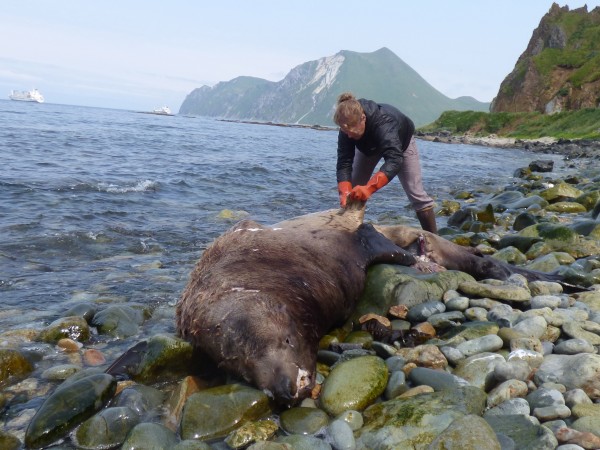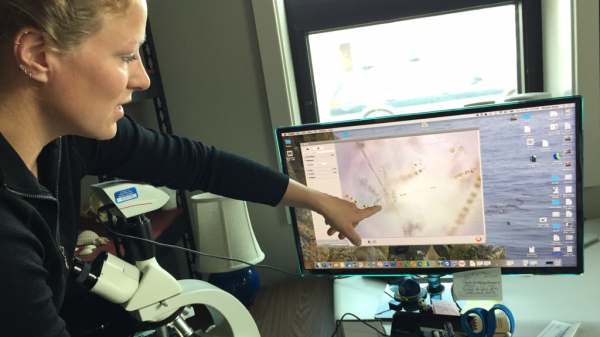Scientists have been receiving reports of dead and dying mammals, birds and small fish in the Aleutian Islands. They think the killer might be toxic algae proliferating in unusually warm ocean waters.
“All the signs are that we’re having a major harmful algal bloom event,” Bruce Wright with the Aleutian Pribilof Islands Association said.
Wright said it could be the algae that cause paralytic shellfish poisoning; the algae that generate domoic acid are another possible culprit.

Melissa Good with University of Alaska Fairbanks has been looking for the microscopic green suspects around Unalaska.
“They’re a suspected cause for some of the mass deaths we’ve been seeing–the 10 fin whales that were spotted dead off of Kodiak Island; I know Adak has seen a lot of dead birds, King Cove, I believe [birds in] False Pass have been washing up. We don’t know the cause of that yet either,” Good said. “In the past, we’ve seen incidences where sand lance, a little plankton-eating fish, was accumulating these high toxins from these algae in their system. The birds were eating sand lance, these small forage fish, and were dying. No one that I know of is sure what happened.”
This week, Good has been taking water samples around Unalaska and shipping them off to labs for full analysis. Even just looking in her microscope on the desk in her office on Thursday, she found large numbers of the domoic acid algae in one of her recent water samples.
She’s also sampled the stomach and flesh of a Steller’s sea lion that washed up dead recently on Unalaska’s Summer Bay, north of the town landfill.
“I didn’t see anything external that looked like a cause of death. Sometimes, there’s gunshot wounds, ship strikes. Those things can be very obvious,” she said after looking over the 10-foot carcass on Thursday.
She thinks toxic algae might have killed this sea lion. One that washed up dead last year near here had very high levels of PSP.
In addition to the stomach, scientists sometimes study fluids in the eye for algal toxins and the whiskers. But eagles had already gotten to the eyes, and someone, Good presumed an Alaska Native with permission to use part of the protected species for materials to decorate a traditional bentwood hat, had removed the whiskers.

Standing next to the fresh carcass, Good said people in the Aleutians should be wary of eating clams or mussels right now.
“We just don’t know if they’re going to be toxic or not,” she said. “You’re taking a lot of risks there.”
Unlike bivalves (such as mussels and clams), crabs don’t retain the toxins in their meat, but in their digestive tracts. Scientists warn people to remove the dark viscera from crab before cooking it.
Shellfish in King Cove and False Pass recently have tested for twice the level of toxins that the U.S. Food and Drug Administration says is safe.
Potentially harmful algae are always present in seawater, but it’s only when they bloom into dense concentrations that they can cause much harm to the things that eat them.
One of the largest harmful algal blooms ever recorded has been taking place this year from California up through British Columbia. Officials in three states have closed beaches to razor clamming and other types of shellfish harvesting.
Researchers think the West Coast bloom, and recent events in Alaska, are related to unusually warm water temperatures.
“We are seeing large blooms throughout Alaska, of different species,” Good said. “When you get warmer water temperatures, they became more prolific, they bloom. You’re getting a high concentration of algae.”
Good says paralytic shellfish poisoning appears to be getting more common in the Aleutians due to increasing water temperatures.
She’s waiting for results on her samples for more conclusive answers. She and Bruce Wright both ask anyone noticing sick or dead predators in the Aleutians to report them. And if you see dead sand lance fish, put a half dozen in a zip-lock bag, freeze it and send it to them.




